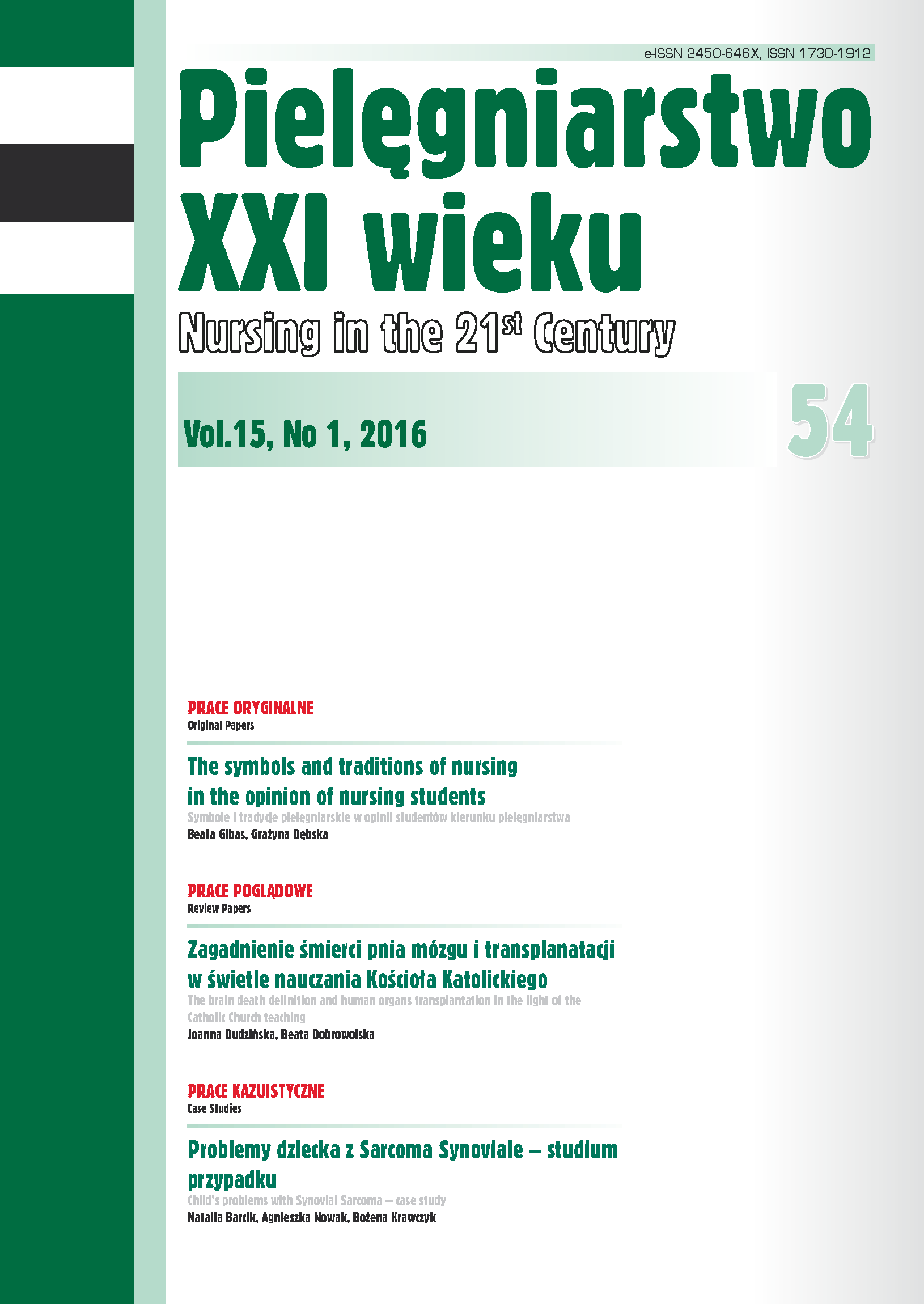Jakość testowego egzaminu wstępnego na kierunek położnictwo studia drugiego stopnia – 5-letnia analiza retrospektywna
DOI:
https://doi.org/10.1515/pielxxiw-2016-0004Słowa kluczowe:
położnictwo, ocena wiadomości, szkolnictwo wyższe, kryteria przyjęć do szkołyAbstrakt
JAKOŚĆ TESTOWEGO EGZAMINU WSTĘPNEGO NA KIERUNEK POŁOŻNICTWO STUDIA DRUGIEGO STOPNIA – 5-LETNIA ANALIZA RETROSPEKTYWNA
Cel. Ocena jakości testowego egzaminu wstępnego służącego do kwalifikacji kandydatów na studia stacjonarne drugiego stopnia na kierunek położnictwo na Warszawskim Uniwersytecie Medycznym.
Materiał i metodyka. Analizie poddano dane dla pięciu roczników kandydatów (N = 335, 100% kobiet), którzy przystąpili do egzaminu wstępnego na kierunku położnictwo w okresie 2009/10 – 2013/14. Zebrane dane dotyczyły wyników egzaminu testowego na studia (sumaryczna punktacja oraz w podziale na bloki tematyczne). Wyznaczono parametry statystyki opisowej, oszacowano łatwość i moc różnicującą pytań oraz oceniono rzetelność testów (alfa-Cronbacha). Wyznaczono ponadto indeksy dyskryminacyjne dla bloków tematycznych testu. Wszystkie obliczenia wykonano w pakiecie STATISTICA 12.5.
Wyniki. Najbardziej optymalny pod względem łatwości i mocy różnicującej dobór pytań zanotowano dla testu z roku 2009/10. Dla żadnej edycji egzaminu nie stwierdzono spełnienia minimalnych wymagań w zakresie wewnętrznej zgodności pomiaru. Najlepsze wyniki dotyczące rzetelności pomiaru zaobserwowano dla testu w roku 2009/10. Analiza mocy dyskryminacyjnej pytań w blokach tematycznych wskazywała na zróżnicowanie tego parametru jakościowego. Bardzo wysoki indeks dyskryminacyjny zanotowano dla bloku pytań z zakresu „opieki specjalistycznej” w roku 2009/10 (0,535), a najniższy w egzaminie w roku 2013/14 (0,150).
Podsumowanie. 1. Konieczna jest poprawa jakości testowych pytań egzaminacyjnych w zakresie trudności oraz mocy różnicującej.
2. Należy monitować jakość kolejnych edycji egzaminu wstępnego w szczególności w odniesieniu do kontroli rzetelności tego narzędzia kwalifikacyjnego.
Bibliografia
1. Drennan J. Professional and academic destination of masters in nursing graduates: a national survey. Nurse. Educ. Today. 2008; 28(6): 751-9.
2. Raines CF, Taglaireni ME. Career pathways in nursing: Entry points and academic progression. Online. J. Issues. Nurs. 2008; 13(3): 3.
3. Kostrzanowska Z, Zarzycka D. Struktura i zasoby pielęgniarstwa europejskiego. [w:] Wrońska I, Krajewska-Kułak E, red. Wybrane zagadnienia z pielęgniarstwa europejskiego. Lublin: Wydawnictwo Czelej; 2007, s. 27-47.
4. Muecke L. Pre- and post-admission criteria as predictors of academic success in an associate degree nursing program. Ames: Iowa State University; 2008.
5. Kuncel NR, Hezlett SA, Ones DS. A comprehensive meta-analysis of the predictive validity of the graduate record examinations: implications for graduate student selection and performance. Psychol. Bull. 2001; 127(1): 162-81.
6. Panczyk M, Zarzeka A, Belowska J, et al. Risk of attrition from Bachelor’s degree of Nursing programme – predictive evaluation. Piel. XXI. 2015; 51(2): 66-72.
7. Uchwała nr 13/2008 z dnia 25 lutego 2008 roku w sprawie uchwalenia zasad i trybu postępowania rekrutacyjnego na pierwszy rok studiów na rok akademicki 2009/2010 w Akademii Medycznej w Warszawie.
8. Niemierko B. Pomiar wyników kształcenia. Warszawa: Wydawnictwo Szkolne i Pedagogiczne; 1999.
9. Jankowski K, Zajenkowski M. Metody szacowania rzetelności pomiaru testem. [w:] Fronczyk K, red. Psychometria - podstawowe zagadnienia. Warszawa: Vizja Press & IT; 2009, s. 84-110.
10. Rhodes ML, Bullough B, Fulton J. The Graduate Record Examination as an admission requirement for the graduate nursing program. J. Prof. Nurs. 1994; 10(5): 289-96.
11. Auerhahn C. Predictors of success in master’s level nurse practitioner programs. New York: Columbia University; 1996.
12. Newton SE, Moore G. Undergraduate grade point average and graduate record examination scores: the experience of one graduate nursing program. Nurs. Educ. Perspect. 2007; 28(6): 327-31.
13. Katz JR, Chow C, Motzer SA, Woods SL. The graduate record examination: help or hindrance in nursing graduate school admissions? J. Prof. Nurs. 2009; 25(6): 369-72.
14. Megginson L. Exploration of nursing doctoral admissions and performance outcomes. J. Nurs. Educ. 2011; 50(9): 502-12.
15. Panczyk M, Rebandel H, Belowska J, et al. Entrance exam for candidates for master’s nursing studies – a 5-year retrospective analysis. Prob. Piel. 2015; 23(3): in press.
16. Panczyk M, Gotlib J. Analiza dyskryminacyjna kryteriów rekrutacyjnych na studia II stopnia na kierunku Pielęgniarstwo na Warszawskim Uniwersytecie Medycznym. Prob. Piel. 2015; 23(1): 51-6.
17. Panczyk M, Ścieglińska B, Woynarowska-Sołdan M, Gotlib J. MSc Nursing Entrance Exams - admission to full-time and part-time programmes at medical university. Prob. Piel. 2015; 22(4): 477-4483.
18. Fleiss JL. Reliability of Measurement. The Design and Analysis of Clinical Experiments. New York: John Wiley & Sons; 1999.
19. Streiner DL. Starting at the beginning: an introduction to coefficient alpha and internal consistency. J. Pers. Assess. 2003; 80(1): 99-103.
20. Guilford JP. Psychometric methods. 2nd ed. New York: McGraw-Hill; 1954.
21. Tarrant M, Ware J. Impact of item-writing flaws in multiple-choice questions on student achievement in high-stakes nursing assessments. Med. Educ. 2008; 42(2): 198-206.
22. Harasym PH, Leong EJ, Violato C, et al. Cuing effect of „all of the above” on the reliability and validity of multiple-choice test items. Eval. Health. Prof. 1998; 21(1): 120-33.
23. Boland RJ, Lester NA, Williams E. Writing Multiple-Choice Questions. Academic Psychiatry. 2010; 34(4): 310-6.
24. Downing SM. The effects of violating standard item writing principles on tests and students: the consequences of using flawed test items on achievement examinations in medical education. Adv. Health. Sci. Educ. Theory. Pract. 2005; 10(2): 133-43.
25. Rozporządzenie Ministra Nauki i Szkolnictwa Wyższego z dnia 9 maja 2012 r. w sprawie standardów kształcenia dla kierunków studiów: lekarskiego, lekarsko-dentystycznego, farmacji, pielęgniarstwa i położnictwa (Dz.U. 2012 nr 0 poz. 631).
Opublikowane
Numer
Dział
Licencja
Prawa autorskie (c) 2016 Autorzy

Praca jest udostępniana na licencji Creative Commons Attribution-NonCommercial-NoDerivatives 3.0 Unported License.




